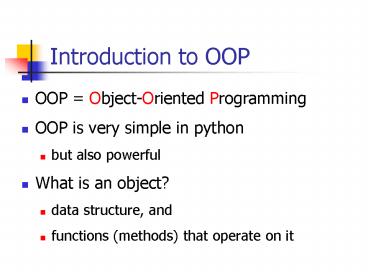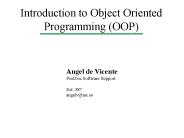Introduction to OOP - PowerPoint PPT Presentation
1 / 31
Title: Introduction to OOP
1
Introduction to OOP
- OOP Object-Oriented Programming
- OOP is very simple in python
- but also powerful
- What is an object?
- data structure, and
- functions (methods) that operate on it
2
OOP terminology
- class -- a template for building objects
- instance -- an object created from the template
(an instance of the class) - method -- a function that is part of the object
and acts on instances directly - constructor -- special "method" that creates new
instances
3
Defining a class
- class Thingy
- """This class stores an arbitrary object."""
- def __init__(self, value)
- """Initialize a Thingy."""
- self.value value
- def showme(self)
- """Print this object to stdout."""
- print "value s" self.value
constructor
method
4
Using a class (1)
- t Thingy(10) calls __init__ method
- t.showme() prints "value 10"
- t is an instance of class Thingy
- showme is a method of class Thingy
- __init__ is the constructor method of class
Thingy - when a Thingy is created, the __init__ method is
called - Methods starting and ending with __ are "special"
methods
5
Using a class (2)
- print t.value prints "10"
- value is a field of class Thingy
- t.value 20 change the field value
- print t.value prints "20"
6
More fun stuff
- Can write showme a different way
- def __repr__(self)
- return str(self.value)
- Now can do
- print t prints "10"
- print "thingy s" t prints "thingy 10"
- __repr__ converts object to string
7
"Special" methods
- All start and end with __ (two underscores)
- Most are used to emulate functionality of
built-in types in user-defined classes - e.g. operator overloading
- __add__, __sub__, __mult__, ...
- see python docs for more information
8
Exception handling
- What do we do when something goes wrong in code?
- exit program (too drastic)
- return an integer error code (clutters code)
- Exception handling is a cleaner way to deal with
this - Errors "raise" an exception
- Other code can "catch" an exception and deal with
it
9
try/raise/except (1)
- try
- a 1 / 0
- this raises ZeroDivisionError
- except ZeroDivisionError
- catch and handle the exception
- print "divide by zero"
- a -1 lame!
10
try/raise/except (2)
- try
- a 1 / 0
- this raises ZeroDivisionError
- except no exception specified
- catches ANY exception
- print "something bad happened"
- Dont do this!
11
try/raise/except (3)
- try
- a 1 / 0
- this raises ZeroDivisionError
- except no exception specified
- Reraise original exception
- raise
- This is even worse!
12
Backtraces
- Uncaught exceptions give rise to a stack
backtrace - python bogus.py
- Traceback (most recent call last)
- file "bogus.py", line 5, in ?
- foo()
- file "bogus.py", line 2, in foo
- a 1 / 0
- ZeroDivisionError integer division or modulo
by zero - Backtrace is better than catch-all exception
handler
13
Exceptions are classes
- class SomeException
- def __init__(self, valueNone)
- self.value value
- def __repr__(self)
- return self.value
- The expression self.value is the same as
str(value) - i.e. converts object to string
14
Raising exceptions (1)
- def some_function()
- if something_bad_happens()
- SomeException leaves function
- raise SomeException("bad!")
- else
- do the normal thing
15
Raising exceptions (2)
- def some_other_function()
- try
- some_function()
- except SomeException, e
- e gets the exception that was caught
- print e.value
16
Raising exceptions (3)
- This is silly
- try
- raise SomeException("bad!")
- except SomeException, e
- print e prints "bad!"
17
Random numbers (1)
- To use random numbers, import the random module
some useful functions include - random.choice(seq)
- chooses a random element from a sequence seq
(usually a list) - random.shuffle(seq)
- randomizes the order of elements in a sequence
seq (usually a list) - random.sample(seq, k)
- chooses k random elements from seq
18
Random numbers (2)
- To use random numbers, import the random module
some useful functions include - random.randrange(start, stop)
- chooses a random element from the range
- start, stop (not including the endpoint)
- random.randint(start, stop)
- chooses a random element from the range
- start, stop (including the endpoint)
- random.random()
- returns a random float in the range (0, 1)
19
Summing up
- Use classes where possible
- Use exceptions to deal with error situations
- Use docstrings for documentation
- Next week more OOP (inheritance)
20
More on OOP -- inheritance
- Often want to create a class which is a
specialization of a previously-existing class - Don't want to redefine the entire class from
scratch - Just want to add a few new methods and fields
- To do this, the new class can inherit from
another class this is called inheritance - The class being inherited from is called the
parent class, base class, or superclass - The class inheriting is called the child class,
derived class, or subclass
21
Inheritance (2)
- Inheritance
- class DerivedClass(BaseClass)
- ltstatement-1gt
- ...
- ltstatement-Ngt
- Or
- class DerivedClass(mod.BaseClass)
- ...
- if BaseClass is defined in another module ("mod")
22
Inheritance (3)
- Name resolution
- foo Foo() instance of class Foo
- foo.bar()
- If bar method not in class Foo
- parent class of Foo searched
- etc. until bar found or top reached
- AttributeError raised if not found
- Same deal with fields (foo.x)
23
Inheritance (4)
- Constructors
- Calling __init__ method on subclass doesn't
automatically call superclass constructor! - Can call superclass constructor explicitly if
necessary
24
Inheritance (5)
- class base
- def __init__(self, x)
- self.x x
- class derive (base)
- def __init__(self, y)
- base.__init__(self, y)
- self.y y
25
Inheritance example (1)
- class Animal
- def __init__(self, weight)
- self.weight weight
- def eat(self)
- print "I am eating!"
- def __repr__(self)
- return "Animal weight d" \
- self.weight
26
Inheritance example (2)
- gtgtgt a Animal(100)
- gtgtgt a.eat()
- I am eating!
- gtgtgt a.weight
- 100
- gtgtgt a.fly()
- AttributeError Animal instance has no attribute
'fly'
27
Inheritance example (3)
- class Bird(Animal)
- def fly(self)
- print "I am flying!"
- b Bird(100) Animal's __init__() method
- b.eat()
- I am eating!
- b.fly()
- I am flying!
28
Multiple inheritance (1)
- Multiple inheritance
- class DerivedClassName(Base1, Base2, Base3)
- ltstatement-1gt . .
- ltstatement-Ngt
- Resolution rule for repeated attributes
- Left-to-right, depth first search
- sorta...
- Actual rules are slightly more complex
- Don't depend on this if at all possible!
29
Multiple inheritance (2)
- Detailed rules
- http//www.python.org/2.3/mro.html
- Usually used with "mixin" classes
- Combining two completely independent classes
- Ideally no fields or methods shared
- Conflicts then do not arise
30
Mixin example
- class DNASequence
- __init__ etc.
- def getBaseCounts(self) ...
- other DNA-specific methods
- class DBStorable
- __init__ etc.
- methods for storing into database
- class StorableDNASequence(DNASequence, \
- DBStorable)
- Override methods as needed
- No common fields/methods in superclasses
31
Private fields
- Private fields of objects
- at least two leading underscores
- at most one trailing underscore
- e.g. __spam
- __spam ? _ltclassnamegt__spam
- ltclassnamegt is current class name
- Weak form of privacy protection































